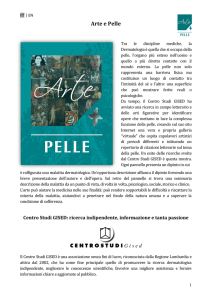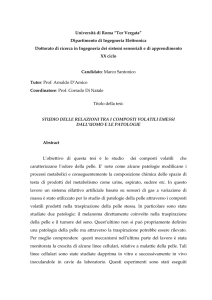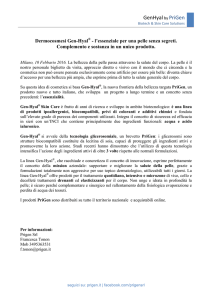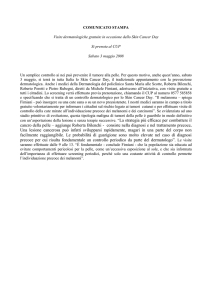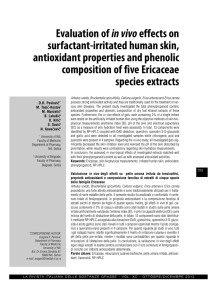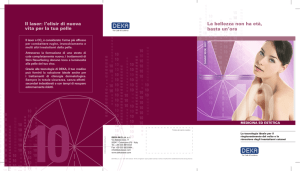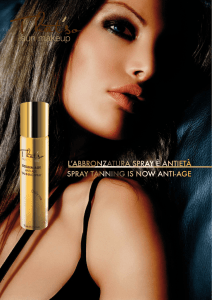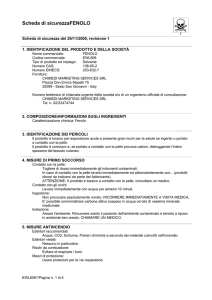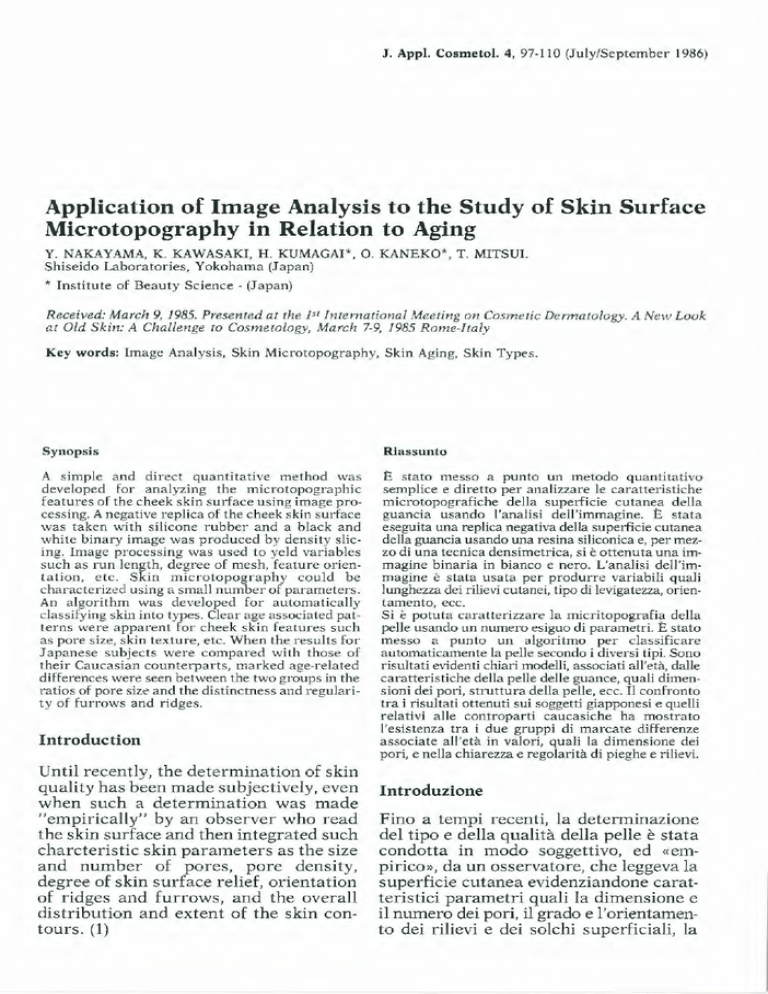
J. Appl. Co smetol. 4, 97- 110 (Ju ly/September 1986)
Application of Image Analysis to the Study of Skin Surface
Microtopography in Relation to Aging
Y. NAKAYAMA, K. KAWASAKI, H. KUMAGAI *, O. KANEKO*, T. MITSUI.
Shiseid o Laboratories, Yokohama (Japan)
* I nstitute of Beauty Science - (Japan)
Received: March 9, 1985. Presented at the 151 International Meeting on Cosmetic Dermatology. A New Look
al Old Skin: A Challenge IO Cosmetology, March 7-9, 1985 Rome-l taly
Key word s: Image Analysis, Skin Microtopography, Skin Aging, Skin Types.
Syno psis
Riassunto
A s imple a nd d irect quantitative method was
developed for analyzing the m icrotopographic
features of the cheek skin surface using image process ing. A negative replica of the cheek skin sur face
was taken w ith silicone rubber and a black and
white binary image was produced by density slicing. I mage processing was used to yeld variables
such as run length, degree of mesh, feature orientation , etc . Skin microtopography could be
characterized using a small number of parameters .
An algorithm was developed fo r automatically
classifying skin into types. Clear age associated palterns were apparent for cheek sk in features such
as pore size, skin texture, etc. When the resu lts for
Japanese subjects were compared with those of
their Caucasian counterparts, marked age-1·elated
d ifferences were seen between the two groups in the
ratios of pore size and the distinctness and regularity of furrows and ridges.
È stato messo a pun to un metodo quanti tativo
semplice e diretto per analizzare le caratteristiche
microtopografiche della superficie cutanea della
guancia usando l'analisi dell'immagine. È stata
eseguita una replica negativa della superficie cutanea
della guancia usando una resina silicon ica e, per mezzo di una tecn ica densimetrica, si è ottenuta una immagine binaria in bianco e nero. L'analisi dell'immagine è stata usata per produ rre variabili quali
lunghezza dei rilievi cutanei, tipo di levigatezza, or ientamento, ecc.
Si è potuta caratterizzare la micritopografia della
pelle usando un numero esiguo di paramet ri. È stato
messo a punto un algoritmo per classificare
automaticamente la pelle secondo i d iversi tipi. Sono
risultati evidenti chiari modelli, associati all'età, dalle
caratteristiche della pelle delle guance, quali dimensioni dei pori, struttura della pelle, ecc. Il confronto
tra i risultati ottenuti sui soggetti giapponesi e quelli
relativi a lle controparti caucasiche ha mostrato
l'esistenza tra i d ue gruppi di marcate differenze
associate all'età in valori, quali la d imensione dei
pori, e nella chiarezza e regolarità d i p ieghe e rilievi.
I ntroduc tion
Un til recently, the d etermination of skin
q ua lity h a s been mad e su bj ectively, even
w hen s uc h a determ in a tion was made
"em pirically" b y an ob server who r ead
the skin surface and the n integra ted such
ch arcteristic skin p aram et e r s as the size
and n u mber of pores, par e den sity,
d egree of skin su rface relief, orie n tation
of ridges a nd fur rows, a nd the overall
distr ibut ion a nd ext e n t o f the skin contour s . (1)
Introduzione
Fino a tempi recenti, la determinazione
del tipo e della qualità della pelle è stata
condott a in modo soggettivo, ed «empir ico», da u n osservatore, che leggeva la
super ficie cutanea evidenzia ndone caratteristici param etri quali la dimensione e
il numero dei pori, il grado e l'orientamento dei rilievi e dei solchi superficiali, la
98
Application of Image Analysis to the Study of Skin Surface
Microtopography in Relation to Aging
Also, it has been generally assumed that
skin quality is related to, or is in som e
way a reflection of, the aging process. A
large number of physiological and environmetal factors are known to combine
and affect the condition of the skin.
Previous studies of skin surface morphology have shown that the skin surface
reflects the events of keratinization and
other physiological functions. (2)
However, techniques such as biopsy and
stripping, which have been used to investiga te skin features and the
physiological condition of the skin, often
a lter damage skin structures of systems.
Therefore, a direct straightforward
method is needed for assessing the
physiological age of the skin.
Severa! attemtps have been made to express the fine detail of the skin surface
quantitatively. In one method, the surface
of the skin is reproduced on same
s uitable materiai by direct contact. This
skin surface replica is then scanned by a
whisker or feeler attached to a profilometer, and the amplitude of the resultant signal is then processed by a
computer to yield numerica! information.
(3) In another method, multiple light
sources are used to obtain consecutive
images of the skin surface and the area
of the shadows cast by the skin surface
features is computed for each illumination direction. This information is then
used as a measure of the surface relief.
(4) capa third method, a large high-speed
computer is used and data are analyzed
and processed by a complicated pattern
processing program to extract information related to skin characteristics. (5)
However, this method is greatly affected
by noise.
These attemtps to classify skin into types
by quantifying the fine detail of the skin
surface have met with limited success.
The results obtained using these procedures do not agree well w ith those ob-
distribuzione generale e l'estensione dei
contorni (1).
Si è dato generalmente per scontato, inoltre, che la qualità della pelle è collegata
al processo di invecchimento o ne è in
qualche misura il riflesso. È noto che un
vasto numero di fattori fisiologici e ambientali determinano e influenzano la
condizione della pelle. Studi precedenti
sulla morfologia della superficie cutanea
hanno dimostrato che quest'ultima riflette il processo di cheratinizzazione e altre
funzioni fisiologiche (2). Tuttavia, tecniche come la biopsia e lo stripping che sono state utilizzate per indagare le caratteristiche e la condizione fisiologica della pelle, spesso ne alterano o ne danneggiano la struttura stessa. È necessario,
dunque, un metodo diretto per valutare
l'età fisiologica della pelle.
Sono stati condotti vari tentativi per descrivere qualitativamente il sottile reticolo cutaneo. Si riproduce la superficie della pelle su un materiale idoneo, per contatto diretto. Questa replica cutanea viene poi riprodotta mediante l'utilizzazione di diversi strumenti grafici che ne riproducono il profilo. L'ampiezza del segnale risultante viene poi eleborata da un
calcolatore al fine di ottenere una informazione numerica (3). Un altro metodo
utilizza fonti di luce multipla per ottenere immagini consecutive della superficie
della pelle; per ciascuna direzione di il i umi nazione viene calcolata l'area delle
ombre prodotte dagli elementi della superficie cutanea. Si ottiene così una immagine tridimensionale. Questa informazione viene poi utilizzata come misura del
rilievo della superficie (4). Un terzo metodo utilizza un calcolatore potente ad alta velocità ed analizza ed elabora i dati
secondo un complicato programma di
elaborazione per derivare l'informazione
relativa a lle caratteristiche della pelle (5).
Questo metodo, tuttavia, è molto influenzato dalle oscillazioni di fondo.
99
Y. Nakayama, K. Kawasaki , H. Kumagai, O. Kaneko, T. Mi tsui
tained b y the subjective evaluation a pproach . In addition, these procedures are
expensive and time consuming, and considerable expertise is required to opera te
the a pparatus, thus rendering he se
methods impractica l. Therefore, a new
quantita tive method was developed far
analyzing s kin s urface morphology us ing
image processing. The variations seen in
skin s urface morphology were then
a n a lyzed from the viewpoint of aging.
Materials and methods
209 healthy Japa nese female volunteers
rang ing in age from 20 to 60 served as
subj ects in this study. A negative replica
of the cheek skin s urface was made with
an o paque quick-drying s ilicone rubber.
The r eplica was then mounted in a metal
casset. Care was take n to preserve the
o rienta tion of the replica with r espec t to
1V
CAMERA
TV
MONITER
Questi tentativi di classificare la pelle per
tipi quantificando il sottile dettaglio del la superficie della pelle hanno avuto scarso successo. I risultati o ttenuti utilizzando queste procedure non concordano con
quelli ottenuti con la tecnica di valutazione soggettiva. Ques te procedure, ino ltre,
sono costose e richiedono tempi molto
lunghi - per far funzionare la strumentazione è necessaria una vasta esperienza
e questo rende tali m etodi poco pratici.
E stato, dunque, m esso a punto un nuovo metodo quantita tivo per analizzare la
morfologia d ella superficie cutanea utilizzando l'analis i dell'immagine. Le variazioni osservate nella morfologia della s uperficie cutanea so no s ta te po i prese in
esam e in relazione a ll 'invecchiame nto.
Materiali e metodi
Ques to studio si è avvalso di 209 volontari sani giappones i di sesso femminile e
C OLOR
CRT
DISPLAY
V IDEO
SIGNAL
PER SON AL
COMPUTER
(16 bit}
DOT MATRIX
PRINTER
FLOPPY
DISK
KEYBOARD
Flg. 1. Image processing system for quantifying the
s kin s urface microtopography of cheek s kin a nd
automa tically classifying cheek skin into skin types.
Fig. l: Sistema di ela borazione di immag ine per
quantificare la microtopografia della superficie cutanea della pelle della gua ncia e per class ifica re automaticamente la pelle della g uanc ia secondo i tipi
di pell e.
Application of Image Analysis to the Study of Skin Surface
Microtopography in Relation to Aging
100
the actual cheek skin. The system configuration is shwon in Fig. l. The heart
of the system is a microcomputer which
is u sed forali image processing, analysis,
and control functions. The skin replica in
the casset was pla ced under a
microscope-TV camera unit which was
enclosed in a light-tight box to prevent
light other than from a controlled source
from striking the r e plica. The replica was
imaged a TV camera and a gray scale image was produced (Fig. 2a). The resulting
image was then divided into 64 contrast
levels (Fig. 2b) and density slicing was used to produce a black and white binary
image consisting of 208 X 208 pixe ls (Fig.
2c).
The binary image of the skin relief was
then scanned in 4 directions and each image elemen t was read as a ei ther a " l " or
di età compresa tra 20 e 60 anni. Si è ottenuto una replica negativa della pelle
della guancia per mezzo di gomma a l silicone opaca a rapido essiccamento. La
replica è stata poi montata su un supporto di metallo. Si è avuta cura di mantenere nella replica lo s tesso orientamento
della pelle della guancia. La Fig. 1 mostra
la configurazione del s istema. Il cuore del
sistema è costituito da un microcalcolatore che viene usato per tutte le funzioni
di e laborazione, analisi e controllo dell'immagine. La replica c utanea montata
sul s upporto è stata posta sotto una unità costituita da una telecamera da microscopio racchiusa in una scatola a prova
di luce in modo da impedire a d una fonte di luce diversa da quella di controllo
di colpire la replica. La replica è s tata tradotta quindi, e trasformata in una imma-
Densi ty-slicing technique
(a)
Binary image
(:::i
::.!=2!2:: bits::::::
1
(b)
(e)
Flg. 2. Explanation of image processing scheme; (2a)
a continuous tone image is produced by the TV
camera; (2b) the image is divided into 64 contrast
levels and those levels above some predetermined
threshould value are read as 1's or dark bits; (2c)
a binary (black and white) image is produced.
Flg. 2: Spiegazione dello schema di elabo razione del1'immagine; (2a) una immagine a tono continuo viene prodotta dalla telecame ra; (2 b) l'immagine è divisa in 64 livelli d i contrasto e quei livelli al di sopra di un certo livello di soglia predetermina to vengono le tti come" I » o bit scuri; (2c) viene prodotta
una immagine bina ria (bianco e nero).
10 1
Y. Nakayama, K. Kawasaki, H. Kumagai, O. Kaneko, T. Mitsui
"O" (Fig. 3). The length of each unbroke n
string of 1's was defined as the run
length. Two parameters were u sed in
analyzing the run length data . The
ari thmetic m ean for the tota! run le ngth
in the image, m, was calculated from the
sum of the run length means for each
scannin g direction. Run length
parameters m was u sed to d e termine the
d egree of skin surface relief and the size
of the pores and hair follicles. Run le ngth
parameter "r" was calculated from two
pairs of means for scanning directions
which were perpendicular to each other.
"r" was used to assess the regularity of
the furrow distribution. In binary images
in which the skin features a re arranged
r adia lly, it can be seen that the "r" value
is close to unity.
The freque ncy dis tribution of the run
le ngth in each scanning directions is
shown in Fig. 4. The re are s ignificant dif-
gine a diversi toni di grigio (Fig. 2a). La
riproduzione risultante è stata poi s uddivisa in 64 livelli di contras to (Fig. 2b) e,
utilizzando la tecnica del taglio delle densità si è potuto ottenere una immagine binaria in bianco e n ero cons istente di
208 X 208 pixel (Fig. 2c).
L' immagine bina ria del rilievo c utaneo è
stata poi scandita in qua ttro direzioni e
ciascun elemento d ell'immagine è stato
le tto con un valore pari a« 1» o a «0 » (Fig.
3). La lunghezza di ciascuna frequenza
ininterrotta di valori« 1 »è stata poi definita come «run length ». Per analizzar e i
dati della run length sono stati usati due
parametri. La m edia aritmetica de lla run
length totale, «ID », ne ll 'immagine è stata
calcolata dalla somma d elle medie dell a
run length per ciascuna direzione di scans ione. Il parame tro della run length, «m »,
è s tato utilizzato per determinare il grado di rilievo d e lla superficie c uta nea e la
li ghl r un
dar k r un
Scan li ne number
m
w
2oa
: :
ITI 1
11::!:
j Jtl J
m, + m.,
bit s
Flg. 3. Scanning of binary image in the run length
a na lysis; image is scanned in 4 directions and eac h
image element is read as either " I " or "O"; the length
of an unbroken string of l 's is run length. (See text
for explanation of the calcula tion of "r" and m).
Flg. 3: Scansione dell 'immagine binaria nell 'analis i della run length; l'immagine è scandita in quattro direzioni e ciascun elemento di immagine è letto
come « I» o «0»; la lunghezza di una sequenza non
in terrotta di« 1 »è la run length (vedere il testo per
la s piegazione del calcolo di «r» ed «m »).
102
Application of Image Analysis to the Study of Skin Surface
Microtopography in R elation to Aging
ferences in the run length distributions
for the binary images shown here. In Fig.
4a, the distributions for the four scanning directions are nearly equa l. This indicates that the ridges are sm a ll a nd that
the furrows and ridges are radiantly
reticular. In contrast to this, the skin s urface image in Fig. 4b. shows a relatively
wide distribution in a ll scanning directions. Thi s indicates the presence of large
pores and ridges. A clearly defined furrow orientation is shown in Fig. 4c. This
feature is expressed as a b road run length
in one scanning direction and a relatively tight distribution pattern in the other
three scanning directions. Pore s ize could
be differentiated u s ing run length
a nalysis parameter m, while the pa ttern
of furrows and ridges was clearly differentiated by run length p arameter "r".
In the mesh analys is, the processed image was divided into a 256-section grid.
Each grid square was composed of a
large number of pixels. The number of
dimen sione dei pori e dei follicoli piliferi. Il parametro della run length «r» è stato calcolato sulla base di due coppie di
medie per direzioni di scansione ch e fossero perpendicolari tra loro. Il parametro «r » è stato utilizzato per valutare la
regolarità della distribuzione dei solchi .
Nelle immagini binarie in c ui le caratteristiche della pelle sono sistemate in modo radiale, si può vedere come il valore
«r» sia prossimo a ll'unità.
La dist r ibuzione di frequenza delle run
length in ciascuna direzione di scansione
è r iportata nella Fig. 4. Vi sono differenze dignificative n elle distrib uzioni della
run length per le immagini binarie qui riportate. Nella Fig. 4a le distribuzioni per
le quattr o direzioni di scansione sono
pressochè uguali. Questo indica che le
creste sono piccole e ch e i solchi e le creste sono radialmente reticolari. In contrasto con ques to dato, l'immagine della s uperficie cutanea nella Fig. 4b mostra una
distribuzione relativamente ampia in tut-
..
..
so
40
40
,..o
;
30
~
<;
~
20
iii = 4.82
ffi = 9.03
r = LOS
r= 1.0 S
10
\
I
I
I
I
\
24
Fig. 4. Frequen cy distributions for each scanning
direction in the run length analysis; (4a) tight and
nearly equa! distributions indicate small, reticularly
radiant furrows and ridges; (4b) wide scanning in
a li d irections indicate large pores and ridges, and;
(4c) a b road run length in a single direction indicates
a clearly d efined furrow orientation.
32
ffi=9.03
...• ·.ì..·',•\
~·..
'-·-.
r = S.90
·~ ·'"'
16
24
Run Length
32
Flg. 4: Le d istribuzioni della frequenza per ciacuna
d irezione di scansione nell'analisi della run length;
(4a) distribuzioni fitte e pressochè uguali indicano
solchi e cres te p iccole, reticolarmente radiali; (4b)
un'ampia scansione in tutte le direzioni indica pori larghi e creste ampie; e (4c) un'ampia run length
in una s ingola direzione indica u n orientamento del
solco chiaramente definito.
Y. Nakayama, K. Kawasaki, H. Kumagai, O. Kaneko, T. Mi tsui
pixels in each grid square with a value of
" 1" was counted and a frequency
distribution was plotted. The sha pe of the
distribution was used as a meas ure of the
s ha rpness or dis tinctness of the ridges
and furrows.
Results and discussion
Data were analyzed in an attempt to corr e l a te c hanges in s kin s u rface
microtopography with ch ronological age.
However, when the subject data were
analyzed in o ne block, no age-related patterns or tre nds were seen for skin
features. Therefore, som e variable other
than age was thought to be respons ible
for the great individuai variatio ns seen in
skin s urface topography. The data were
re-examined and 6 s kin types were identified based on dis tinct differences in skin
fea tures. The data were therefore
r egrouped according to skin type. Typical
binary images of the six skin types a r e
shown in Fig. 5.
103
te le direzioni di scansione. Questo indica la presenza di pori larghi e creste ampie. La Fig. 4c mostra un orientamento
dei solchi chiaramente definito. Questa
caratteristica è espressa come una ampia
run length in una direzione di scan s ione
e un disegno di dis tribuzione rela tivam ente fitto nelle altre tre direzioni di
scansione. La dimens ione dei pori può essere stabilita utilizzando il parametro
«ID » di analis i de lla run length, mentre il
disegno dei solchi e delle creste fu chiaramen te identificato con il parametro «r»
di run length.
Nell 'analisi della levigatezza, l' immagine
ela borata è stata s uddivisa in una griglia
di 256 sezion i. Ciascun quadrato della griglia era compos to di un elevato numero
di pixel. Si è contato il numero di pixel
in ciascun quadrato della griglia con un
valore pari a« 1,, e si è r iportata in grafico la distribuzione di frequenza. la forma
de ll a di stribu zione è s tat a utilizzata com e misura della chia rezza e nitidezza delle cres te e dei solchi.
Ill
-,~~.-? ~~-~ ·:~
.·...~-::..
.· ··:..
.'
..
r. ...--. . ------:---.:
..... ... :.. .
:.:..
-·
"- . ·"'
-~
.
Flg. S. Typical bina ry images of the s ix skin types.
Flg . .5: Tipiche immagin i binarie dei sei tipi d i pelle.
Application of Image Analysis to the Study o f Skin Surface
Microtopography in Relation to Aging
104
Risultati e discussione
An a l gori thm was developed for
automatically determining skin type u s ing this microcomputer-based image processing system. Both the run length and
m esh analysis parameters are integra!
factors in determ ining the six skin types.
Figure 6 s hows the distribution of skin
types throughout each age group. Type 1
skin is reticula rly regular and was seen
only in subjects in their 20's. There is a lso
a noticeable shift in the distribution of
skin types w ith increasing ch ronological
age. It is interesting to n ote t hat percentage of Type II skin is less in each successive age group.
Within each skin type, c lear age-related
patterns were also apparent far skin
features such as pare s ize and skin texture. The r u n length parameter
demonstrated that pare size was larger
in each successive age group far s ubjects
w ith Type V + VI skin. Run lenght
parameter "r" also revealed increasing
feature irregula ri ty in successive age
groups far Types III + IV skin (Fig. 7).
Age-re lated changes were a lso apparent
when the coefficient of mesh analysis,
"ve", was used. Furrow irregularity was
seen to increase s ignificantly with age in
s kin types I + II while the depth of fur-
o
(N
I dati sono s tati analizzati al fine di correlare le alterazioni della microtopografia della superficie cutanea con l'età cron ologica. Tuttavia, quando i dati di un
sogget to venivano analizzati nel loro ins iem e non si riscontrava nelle caratter is tiche della pelle alcun disegno o tendenza collegabile all'età. Pertanto, si ritenne
che qualche altra variabile diversa dall'età fosse responsabile delle consistenti var iazioni individuali riscontrate nelle topografie della supeficie cu tanea. I dati sono stati riesaminati e s i sono identificati
sei tipi di pelle sulla base di chiare differen ze dei car atteri cutanea.
I dati sono stati, pertanto, nuovamente
raggruppati s ulla base dei tipi di pelle. La
Fig. 5 mostra le tipiche immagini binarie
dei sei tipi di pelle.
È stato sviluppato un algoritmo per la determinazione a utomatica del tipo di pelle utilizzan do questo sistema di elaborazione dell'immagine. Sia i parametri della run length che quelli analitici della levigatezza sono fattori fondamentali per
la determinazione dei sei tipi di pelle.
La Fig. 6 mostra la distribuzione dei tipi
di pelle attraverso ciascun gruppo di età.
60
40
20
80
100%
: ::
~os9) ~
~-....___rr_ _,__m
__ _rv__J1_L_J1
Vl
Age
..Ll
(N~o6o) ._J_rr_~_ _m_ ___,_l_rv~l_v~Ivi~I
(N!oss) J'--_
=35 ) IL_JI--1,_
50~60
(N
m
______,Je_rv_,,___v_,,,_l_vi_.I
JI _..,.___ _
_ m_
__JL,__rv
_
Fig. 6. Distribution of skin type according to age
group.
I
___c_ v_ _JL,__ vi_
......J
Fig. 6: Distribuzione del tipo di pelle a seconda del
gruppo di età.
Y. Nakayama, K. Kawasaki, H. Kumagai, O. Ka neko, T. Mi tsui
rows tended to decrease slinghtly (Fig. 8).
Additional analysis were performed in an
attempt to identify age-associated
changes. Data for the originai 6 skin types
were aggregateci and reanalyzed according to the following 3 groups: (I + II),
(III + IV), and (V + VI) (Fig. 9).
Group (I + II) s howed distinct ridges and
furrows and accounted for more than
50 % of the s ubjects in the ir 20's. The
number of subjects with this type of skin
decreased markedly to 10% by age 50. In
contras t, subjects with Group (V + VI)
skin exhibiting large pores accounted for
only 5% of the subjects in their 20's.
However, this number increased marked-
105
La pelle del tipo I è reticolarmente regolare ed è stata riscontrata soltanto in soggetti di età compresa tra i 20 e 30 anni.
Con l'aumentare dell'e tà cronologica s i è
rilevato anche un considerevole spostam ento n elle distribuzioni dei tipi di pelle. È interessante notare che la percentuale della pelle del tipo II è minore in ciascun s uccessivo gruppo di età.
All'interno di ciascun tipo di pe lle, erano
a nche eviden ti chiari modelli correlati a l! 'età per caratteri della pelle quali la di mensione dei pori e la s truttura dell a pelle. Il parametro della run length ha dimostrato come la dimensione dei pori fosse
maggiore in ciascun successivo gruppo di
Pere s ize
IE io
èii
8
E
~
a.
6
a;
IP < O 05 )
\ '. VI
.<=
a.e
..
-!
2
"
0'---'-~---"'"--~~~-
e
~
20
30
40 age
lrregu larity of furrow s
20
Flg. 7. Age-associated changes in pore size and furrow irregularity; (upper) a s ignificant increase in
pore size is dem ons trated by run length parameter
m for skin types V + VI (p < 0.05); (lower) run
length parameter " r" reveals increasing furrow irregula rity for skin types III + IV.
30
40 age
Fig. 7: Alterazioni associate all 'età della dimensione dei pori e della irregolarità dei solchi; (in alto)
un aumento sig nificat ivo della dimensione dei pori
è dimostrato dal parametro «m» della run length per
i t ipi di pelle V + VI (p < 0,05); (in basso) il param etro «r » della run length rivela una aumentata irregolarità dei solchi per i t ipi d i pelle III + IV.
Application of Image Analysis to the Study of Skin Surface
Microtopography in Relat ion to Aging
106
ly to 40 % by age 50. In subjects w ith
Group (III + VI) skin, indis tinct a nd irregular skin p rofil es were seen in as
many as 40% of the subjects in their 20's .
This number gradually increased to 55 %
by age 50.
An intuitive approach to skin aging would
su ggest that Group (III + VI) skin should
b e seen primarily in older women. This
seems reasonable given the assumption
that dry skin is the result of environmental factors acting in conjunction wit h
genetic factors s uch as the ra te of aging.
However, thi s type of skin was seen
unexpec tedly--perhapas prematurely-even in young subjects.
In order to determ ine if these age related
età per soggetti aventi una pelle del tipo
V o VI. Il parametro «r» della run length
ha anche mostrato un aumento di irregolarità dei caratteri nei successivi gruppi
di età per i tipi di pelle III e IV (Fig. 7).
Le a lter azioni collegate all'età erano anche evidenti quando s i utilizzava il coefficiente di analis i della levigatezza «VC» .
Si è visto come l'irregolarità dei solchi
a umentasse in modo significativo con l'età nei tipi di pelle I e II, mentre la profondità dei solchi tendeva a d iminuire
leggermente (Fig. 8)
Si sono condotte ulteriori analis i allo scopo di identificare le a lterazioni collegate
a ll'età. I dati dei sei tipi di pelle originari sono stati associati e rianalizzati secon-
Oepth of lurrows
12
I .a
>-
·;;;
10
e:
"'
'O
Qi
)(
·a.
6
o
o
U)
o
e: 1.0
.e
~ 0.8
;;;
>
.r:;
"'"'E
o
e:
0.6
0.4
"'
0.2
Q;
o
~
o
(,)
20
30
40 age
lrregularity of furrows
..
IP < 0.01)
I .O
r--+---1
20
Fig. 8. Age-associated changes in furrow irregularity
and furrow depth; (upper) furrow depth tends to
decrease with age for subjects wit h s kin types I +
II; (lower) furrow irregularity increases significantly
in subjects with skin types I + II (p < 0.0 1).
30
40 age
Flg. 8: Alterazioni collegate all'età della irregolarit à e della profondità dei solchi; (in a lto) la profondità dei solchi tende a diminuire con l'età nei soggetti aventi pelle dei t ipi I + II; (in basso) l'irregolarità dei solchi a umenta in modo s ignificativo nei
soggetti aventi pelle dei tipi I + II (p < 0,01).
107
Y. Nakayama, K. Ka wasaki, H . Kumagai, O. Kaneko, T. Mitsui
(% )
100~----------------~
60
···O ............. o
()"
...
..
40
.··
20
·····
.·•
O'-----'---__.._ _ ___.._ _ ___,.___ _,
20
I
30
Age
+ n <>--<>
5 0- 60
40
fu rro ws and ridges are disti nct
and re tic ularly regular.
V+ VI • · · · • po res are large.
lii + IV o .. -0
furrow s and ridges are indistinct
and irregular.
Flg. 9. Age-associated changes in the skin sui·face
features of Japanese su bjects .
,..,
Flg. 9: Alterazioni associate all'età dei caratteri della
superficie cutanea di soggett i giapponesi.
(•.)
100~----------.
Japanese
100 ~----------.
Caucasians
.. ··
60
60
() ........<>··· ..... ()
..
40
.•
-··
.··
...•
20
·
40
20
_
..·
..
•
"
20
30
40
Age
50 - 60
0'---2~0--3~0-4~
0-5-0~'-60-'
Age
1 + a o---o furrows an d ridges are distinct and retic ularly reg ular.
V + VI • ····• pores are large.
m+ IV<>···-<>
furrows and ridges are indis tinct a nd irregular.
Fig. 10. Ratios of skin surface featu res in the skin
profiles of J a panese and Ca ucasian women.
Fig. 10: Rapporto tra le caratteris tiche della superficie cutanea nei profili di pelle di d o nne giapponesi e caucasiche .
108
Application of Image Analysis to the Study of Skin Surface
Microtopography in Relation to Aging
chan ges were specific to J apanese
women, the cheek skin of 176 Caucasian
women in New York City was examined
using t he same procedure. A comparison
of age-related changes in skin profiles is
shown in Fig. 10. For the Caucasians, the
skin type d istribu tion was s ignificantly
different from that of their Japanese
counterparts. The ratio of Cau casian subjects with large pores was markedly
highter than that for the Japanese
subjects.
Caucasians with fine, reticularly regul ar
Group (I + II) skin s howed a pattern
s imilar to that of the Japanese subjects
a lthough the percentage of subj ects with
this type of skin was slightly less far middle aged women. Although not statistically s igni ficant, Caucasian s ubjects w ith
this type of skin tended to "age quicker"
than their Japanese counterparts. Also,
the ratio of Cau casian women w ith irregular and indistin ct features was in a li
cases m arkedly less than that of their
J apanese counterparts.
Compared to the study by Corcu ff et al.
on skin aging showing the specific patterns
of
the
sk in
s urface
microtopography on the volar forearm
a nd other body sites, it was much m ore
difficul t to clarify the age-associated
changes in facial skin (cheek skin). This
is because there are wide individua!
variations in the cheek skin r esulting
from differences in ana tomy, the a rchitectu re of the dermis and the unde rlying superficia l facial muscles, and the
influence of environmental factors s uch
exposure to the sun and wind and to the
extremes of temperature and humidity,
in addition to the influence of geqetic factors. Nevertheless, th e quantita tive
analysis presented in this p aper was ab le
to provide specific parameters which
made it possible to identify the features
of the skin s urface topography of facial
skin.
do i seguenti tre gruppi: (I + II), (III + IV),
e (V+ VI) (Fig. 9). Il gruppo (I + II), che int eressava più del 50% dei soggetti in età
compresa tra 20 e 30 a nn i, presentava
creste e solchi distinti. Il numero dei soggetti aventi questo tipo di pelle d iminuiva in modo rilevante fino al 10% nella fascia dei 50 anni di età. Al contrario, i soggetti aventi pelle del gruppo (V+ VI), che
presenta pori larghi, am montavano a solo il 5% dei soggetti di età compresa tr a
20 e 30 anni. Comunque, questo numero
saliva al 50% nella fascia dei 50 a nni di
età. Nei soggetti aventi la pelle del gruppo (III + IV), s i sono osservati profili di
pelle indistinti e irregolari nel 40 % dei
soggetti di età compr esa tra 20 e 30 anni.
Questo numero aum entava gradualmente fino a raggiungere il 55% nella fascia
dei 50 anni di età.
Sembrerebbe così che la pelle del gruppo (III + IV) dovrebbe essere riscontrabile essenzialmente nelle donne p iù anziane.
Questo sembra ragionevole se si accet ta
il presu pposto che la pelle secca è il ris ultato di fattori ambientali che operano
in collegamento con fattori genetici q uali la velocità dell'invecchiamento. Comunque, questo tipo di pelle è stato osservato inaspettatamente - forse prematuram en te - persino in soggetti giovani.
Al fine di determinare se queste alterazioni collegate all'età fossero specifiche delle donne giapponesi, s i è esaminata la pelle delle gua nce di 176 donne caucasich e
di New York utilizzando la stessa procedura. La Fig. 10 mostra un confronto delle alterazioni dovute a ll'età in profili cutanei. La distribuzion e del tipo di pelle è
stata, per i soggetti caucasici, s ignificativamente differente da quella delle loro
con troparti giapponesi. Il numero dei
soggetti caucasici caratterizzati da larghi
pori s i è rivelato s ignificativament e più
alto di quello de i soggetti giapponesi.
I soggetti caucasici aventi una pelle sot-
Y. Nakayama, K. Kawasaki, H. Kumagai, O. Kaneko, T. Mitsui
Conclusions
The present s tudy presented a simple,
straightforward image processing and
analysis system for quantita tively assessing the microtopography of the s kin
r elief. Severa! parameters obtained from
the run length and mesh a nalyses we re
found to be useful in identifying specific
skin microtopographic features such as
"distinctness", regularity of furrows and
ridges, and pore s ize. An a lgorithm was
developed which enabled the sk in
measurement system to a utomatica lly
classify skin images into one six skin
ty pes.
Typical age-associ ated c hang es in
microtopography could b e ide ntified only a fter the processed images had been
classified according to s kin type . The
comparison of age-associated changes in
skin relief between Japanese and Caucas ian women r evealed different ratios of
skin ty pes and differe nt aging patterns.
I t is not clear whether these differences
are due primarily to genetic or environmental factores .
The present system provides a relatively
s mall, low cos t, easy-to-operat e apparatus that can be used for autom atically measuring skin surface characteristics
and determining skin ty pe. Objecti ve indices can be obtained by a n unskilled
operator after only a sh ort training
p eri od.
109
tile, r egolarment e reticolare del gruppo
(I+ II) hanno rilevato un disegno s imile a
quello de i soggetti giapponesi sebbene la
percentuale dei soggetti con questo tipo
di p elle fosse significativamente inferiore ne lle donne di m ezza età. Sebben e in
modo, non s ignificativo dal punto di vista statistico, i soggetti cau casici aventi
questo tipo di pelle te ndevano ad «invecchiare più rapidamente» delle loro controparti giappones i. Inoltre, la pe rcentuale di donne caucasiche con caratteri irregolari e indis tinti era in tutti i casi s ignifi cativamente inferiore a quella d elle loro controparti giapponesi.
Utilizzando la metodica di Corcuff e coli. ,
s ull'invecchiamento della pelle, ch e mostra i disegni specifici della microtopografia del la superficie cutanea sulla parte inte rna dell'avambraccio ed in a ltre zone, risulta mo! to più difficile ide ntificare le alterazioni collegate all'età ne lla pelle de l viso (pe lle de lla guancia). Ques to
perché vi sono a mpi e variazioni individuali nella pelle de lle gua ncie com e risulta to di differenze anatomiche - l'architett ura de l derma e i sottostanti muscoli facciali s uperfic iali - e d ell 'influe n za di fattori ambientali qua li l'esposizione al sole, a l ven to, a temperature eccess ive e a ll 'umidità, in aggiunta all 'influe nza dei
fattori genetici. Cionostante, l'analis i
quanti tativa presentata in questo d ocumento è stata in grado di fornire parametri specifici che hanno r eso possibile identificare i car atteri della topografia della
s uperficie cutanea de lla pelle de l viso.
Conclusioni
Il presente s tudio descrive un s is tema
semplice e diretto d i elaborazione ed analis i di immagine per la valutazione quantitativa della microtopografia del rilievo
c utaneo. Si è riscontrato che vari param etri ottenuti mediante la r ilevazione della
110
Application of Image Analysis to the Study of Skin Surface
Microtopography in Relation to Aging
run length e della levigatezza cu tanea sono utili per identificare specifici caratter i microtopografici della pelle qua li «nitidezza», r egolarità dei solchi e delle cres te, e dime ns ioni dei po ri. Si è svilupp ato un algoritmo che ha r eso possibile un
sistema di misurazione della pelle in grado di classificare autom aticamen te le imm agini cutanee in uno dei sei tipi di pelle.
Soltanto dopo aver classificato secondo
il tipo di pelle le immagini eleborate si sono potute identificare le tipiche alterazioni della microtopografia associate all'età. Il confronto delle a lterazioni associate all'età ne l rilievo della pelle tra le d onne caucasiche e quelle giapponesi h a rilevato una di versa di stribuzione del tipo
di pelle e differenti modelli di invecchiam e nto. Non è chiaro se queste differenze
sia no dovute principalmente a fattori gen etici o a mbie nta li.
Questa nuova metodica di studio necessita di una apparecchiatura relativamente piccola, di basso costo e facil e uso, che
pu ò essere u tilizzata per la misurazione
automa tica delle caratteristiche della s uperfic ie cutanea e per determinare il tipo di pelle. Un operatore senza alcuna
specifica preparazione, dopo soltanto un
breve periodo di a ddestramento, può ottenere risultati obiettivi.
REFERENCES
1. H. Kumagai, K. Shioya, K. Kawasaki, I. Horii, J. Koya ma, Y. Nakayama, W. Mori, and S. Ohta (1984)
«Development of a Scienti fic Method for Classificat ion of Facial Skin Types». Congreso /nternacional
de la l .F.S.C.C. 1 1-19.
2. J. Koyama, I. Ho rii, K. Kawasaki, Y. Nakayama, Y. Morikawa, T. Mltsui and H . Kumagai (1984) «Free
amino acids of the evaluate dry skin». J. Soc. Cosmet. Chem., 35-183.
3. T.H. Cook, T.J. Craft, R.L. Brunelle, F. Norris and W.A. Grifftn (1982) «Quantification of skin topography
by s kin profilometry». lnt. J. Cosmet. Sci., 4 195.
4. P. Corcuff, J. de Rigai and J .L. Leveque (1983) «Skin relief and aging». J. Soc. Cosmet. Chem. 34 177-190.
5. T. Ka minuma Tokyo Metropolitan institute of Medicai Science, Kita-Ku, Tokyo, Japan (unpublished
data).

